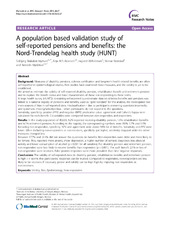A population based validation study of self-reported pensions and benefits: the Nord-Trøndelag health study (HUNT)
Myrtveit, Solbjørg Makalani; Steinsland Ariansen, Anja Maria; Wilhelmsen, Ingvard; Krokstad, Steinar; Mykletun, Arnstein
Peer reviewed, Journal article
Published version
Permanent lenke
https://hdl.handle.net/1956/8486Utgivelsesdato
2013-01-23Metadata
Vis full innførselSamlinger
Originalversjon
https://doi.org/10.1186/1756-0500-6-27Sammendrag
Background: Measures of disability pensions, sickness certification and long-term health related benefits are often self-reported in epidemiological studies. Few studies have examined these measures, and the validity is yet to be established. We aimed to estimate the validity of self-reported disability pension, rehabilitation benefit and retirement pension and to explore the benefit status and basic characteristics of those not responding to these items. A large health survey (HUNT2) containing self-reported questionnaire data on sickness benefits and pensions was linked to a national registry of pensions and benefits, used as “gold standard” for the analysis. We investigated two main sources of bias in self-reported data; misclassification - due to participants answering questions incorrectly, and systematic missing/selection bias - when participants do not respond to the questions. Sensitivity, specificity, positive (PPV) and negative (NPV) predicative value, agreement and Cohen’s Kappa were calculated for each benefit. Co-variables were compared between non-responders and responders. Results: In the study-population of 40,633, 9.2% reported receiving disability pension, 1.4% rehabilitation benefits and 6.1% retirement pension. According to the registry, the corresponding numbers were 9.0%, 1.7% and 5.4%. Excluding non-responders, specificity, NPV and agreement were above 98% for all benefits. Sensitivity and PPV were lower. When including non-responders as non-receivers, specificity got higher, sensitivity dropped while the other measures changed less. Between 17.7% and 24.1% did not answer the questions on benefits. Non-responders were older and more likely to be female. They reported more anxiety, more depression, a higher number of somatic diagnoses, less physical activity and lower consumption of alcohol (p < 0.001 for all variables). For disability pension and retirement pension, non-responders were less likely to receive benefits than responders (p < 0.001). For each benefit 2.1% or less of non-responders were receivers. False positive responses were more prevalent than false negative responses. Conclusions: The validity of self-reported data on disability pension, rehabilitation benefits and retirement pension is high – it seems that participants’ responses can be trusted. Compared to responders, non-responders are less likely to be receivers. If necessary, power and validity can be kept high by imputing non-responders as non-receivers.

